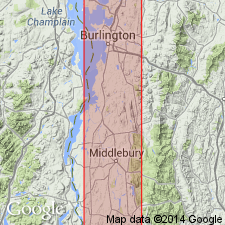
- Usage in publication:
-
- Bascom formation
- Modifications:
-
- Original reference
- Dominant lithology:
-
- Limestone
- Dolomite
- Sandstone
- Quartzite
- Breccia
- Shale
- AAPG geologic province:
-
- New England province
Summary:
Pg. 524, 539, 540, 542-545. Bascom formation of Beekmantown group. In addition to limestone, formation contains dolomite, sandstone, quartzite, limestone breccia, and sandy calcareous shales. Variation in lithology very distinctive. Four zones recognized. Generalized section for Hinesburg synclinorium is (ascending) white marble or limestone with thin sandy or argillaceous stripes; buff dolomite and thin-bedded dolomitic quartzites; "curdled" limestone, some bedded dolomite; and thin-bedded slaty quartzites and sandstones. Thickness approximately 375 feet. Underlies Bridport dolomite (new) conformably; overlies Cutting dolomite (new) conformably. Underlies Crown Point limestone east of meridian of Cornwall, west-central Vermont. Corresponds to Division D of the "Calciferous" (Brainerd and Seely, 1890, Amer. Mus. Nat. Hist. Bull., v. 3). Strata in west-central Vermont designated as lower Chazy (Brainerd, 1891, GSA Bull., v. 2, p. 299) actually appear to be uppermost Bascom beds of Beekmantown group (Beekmantownian). [Age is Early Ordovician.]
Named from "Bascom's Ledge," eastern Shoreham Twp., Addison Co., central western VT.
Source: US geologic names lexicon (USGS Bull. 1200, p. 227-228).
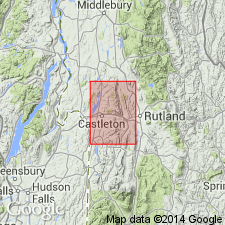
- Usage in publication:
-
- Bascom formation
- Modifications:
-
- Revised
- AAPG geologic province:
-
- New England province
Summary:
Pg. 27-28, pls. 1, 2 (corr. chart, geol. map). Bascom formation. Blue-gray and white banded marble containing beds of dolomite, sandy phyllite, phyllite, and sandstone. Estimated thickness about 500 feet. In Castleton area, formation is included in Valley sequence. Overlies Columbian marble member of Boardman formation (new). Questionably underlies Burchards limestone disconformably. Age is Early Ordovician (Canadian; Jefferson City to Black Rock provincial stages).
Source: Publication; US geologic names lexicon (USGS Bull. 1200, p. 228).
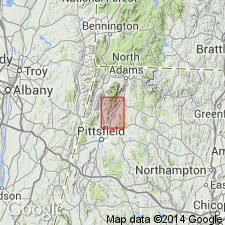
- Usage in publication:
-
- Bascom formation*
- Modifications:
-
- Revised
- Age modified
- AAPG geologic province:
-
- New England province
Summary:
Assigned to the Stockbridge group in northwest MA. Age is Early Ordovician.
Source: GNU records (USGS DDS-6; Reston GNULEX).
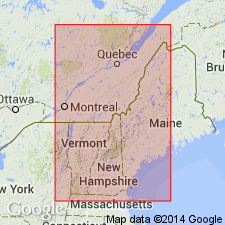
- Usage in publication:
-
- Bascom Formation*
- Modifications:
-
- Revised
- AAPG geologic province:
-
- New England province
Summary:
Assigned to Beekmantown Group in VT.
Source: GNU records (USGS DDS-6; Reston GNULEX).
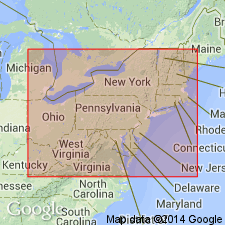
- Usage in publication:
-
- Bascom subgroup [informal]
- Modifications:
-
- Revised
- AAPG geologic province:
-
- New England province
Summary:
Bascom subgroup [informal] is defined as the entire carbonate clastic succession of the Beekmantown, representing the core of the group. This sequence was referred to as "Calciferous sand-rock" by Eaton (1824). Bascom name is appropriate since Bascom Ledges consist of various portions of this sequence. Included within this subgroup are (ascending) Cutting Hill Formation [Cutting Formation of Cady (1945) redefined and renamed], Lemon Fair Formation (new), and Fort Cassin Formation. Unit overlies Whitehall Dolostone and underlies Providence Island Formation, both of Beekmantown Group. Age is Early Ordovician.
["Subgroup" not recognized as a formal stratigraphic rank term (CSN, 1933; ACSN, 1961, 1970; NACSN, 1983, 2005, 2021). Considered informal and should not be capitalized.]
Source: Modified from GNU records (USGS DDS-6; Reston GNULEX).
For more information, please contact Nancy Stamm, Geologic Names Committee Secretary.
Asterisk (*) indicates published by U.S. Geological Survey authors.
"No current usage" (†) implies that a name has been abandoned or has fallen into disuse. Former usage and, if known, replacement name given in parentheses ( ).
Slash (/) indicates name conflicts with nomenclatural guidelines (CSN, 1933; ACSN, 1961, 1970; NACSN, 1983, 2005, 2021). May be explained within brackets ([ ]).

